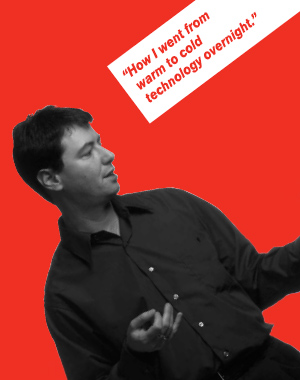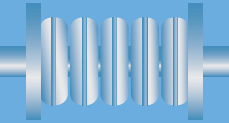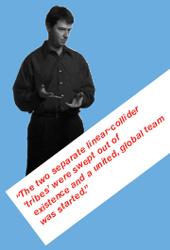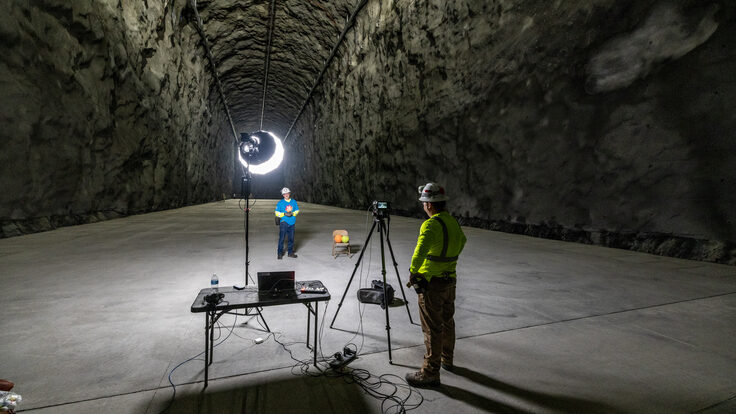Two Tribes Become One
by Peter Tenenbaum
 Photo: Reidar Hahn, Fermilab |
A physicist who has devoted his career to developing linear colliders confronts the decision that changed the global physics community and the focus of his work.
Linear colliders represent my entire career in physics. Starting in 1991 with my PhD work on the Final Focus Test Beam at Stanford Linear Accelerator Center (SLAC), I then moved to CERN, the European particle physics center, for a year of "postdoc-ing" on the Compact Linear Collider (CLIC) Test Facility 2, and then back to SLAC as a postdoc and staff member on the Next Linear Collider (NLC) Test Accelerator. Some of that work, like the FFTB, has been related to linear colliders in general, but most of it has been more specific to a particular design. Since 1998, I'd been working mainly on preserving the high beam quality required for a linear collider, in the context of so-called "warm" technology, based on room-temperature, copper accelerating structures proposed for the NLC.
In 1991, there were groups considering a half-dozen possible technologies for the linear collider. By 2004, there were two tribes: one working on high-frequency, normal-conducting "warm" technology, and the other on low-frequency, superconducting "cold" technology. It had been clear for years that somebody, somehow, was going to need to make a choice between them: Enter the International Technology Recommendation Panel (ITRP), a committee of 12 charged by the International Linear Collider Steering Committee with cutting that Gordian knot.
We in the linear-collider world had been living for so long with the simultaneous need for a decision to be made, and the absence of any person or mechanism to make that decision, that the very idea of a world "After the Choice" was hard to imagine. Even after the ITRP was empanelled and making its site visits, there was anxiety that somehow the panel might become deadlocked, unable to reach a conclusion. This was not a reflection on the ITRP or its members, but a consequence of the choice hanging over all of our heads for so long.
Fortunately for us all, it didn't happen that way. On August 20, 2004, Jonathan Dorfan, the SLAC director and chair of the International Committee for Future Accelerators, announced the decision in Beijing: ICFA had accepted the International Technical Recommendation Panel's judgment that superconducting radio-frequency (rf) technology was the best choice for the main linac of the International Linear Collider.
In a day, in that moment, the world I had lived in for 14 years was transformed. It was done, the choice was made, and the world high-energy physics community could absorb that decision and begin working together on the International Linear Collider (ILC). Our two tribes became one.
 |
The making of a new world
As Dorfan made the announcement on Friday morning in Beijing, it was 10 p.m. Thursday night in California. Like most of my SLAC colleagues, I sat in front of my computer at home, reloading the interactions.org ITRP announcement page. After a few minutes it changed to an announcement of the choice -- the ILC was going "cold."
I was stunned. In all honesty, I had expected the ITRP to select the warm technology that I'd come to know so well. But even more than that: I was excited. I knew that I was now living in that world we hadn't been able to imagine -- the world "After the Choice." I knew that we'd taken a huge step towards making the linear collider a reality. I also knew that I wouldn't be getting too much sleep that night, with the intensity of emotions and excitement I felt: the decision was made and a new era was dawning.
It is to the tremendous credit of the SLAC laboratory and its NLC management, and the TESLA collaboration management at the German laboratory DESY, that they wasted no time, after the decision, demonstrating their commitment to the ILC. Years ago the lab directors had promised to support the ILC no matter what the technology choice ultimately was, but it was easier to say that when the choice was such a complete abstraction that nobody even had any idea how to make it or when it would be made. The real measure of commitment comes the day after the choice has been made. It was easy enough to imagine a scenario in which the "warm" team was not welcome to participate fully, or the priority of the ILC at the "warm" labs was reduced after the choice, but that's not what happened. All involved have demonstrated a commitment to forming a single team in which all participants are welcome, whether they originated in a "warm" or "cold" lab, and in which the former "warm" lab members can count on the continued support of their home institutions at a very strong level.
 The cold technology cavities are made of niobium and cooled to liquid helium temperatures (about 4 Kelvin). |
There's a lot of focus on the technology choice, but it's worth noting a second milestone from that day in Beijing: the two separate linear-collider "tribes" were swept out of existence and a united, global team was started. In many respects, it's this second change that has been harder to get our arms around because it involves a lot more coordination with more people and groups over more time zones. Fortunately weve had practice: both the TESLA and NLC collaborations had been gradually growing and adding new labs and universities over the last few years. In 2002, all the linear-collider groups were involved in the ILC Technical Review Committee's second report. The ILC-TRC was a sort of dress rehearsal for the current ILC in some ways, since all the groups, all over the world, were working together on the studies and content that would make up the report. That was the first time I'd worked closely with linear-collider beam-dynamics experts from Europe and Asia, and it was good preparation for today's ILC collaboration.
Another change since the technology choice was announced is a dramatic increase in the number of people and institutions (both laboratories and university groups) that are participating in the ILC. I think these groups chose to jump in because of expectations that the ITRP was nearing a decision. With the technology choice made, the linear collider becomes a more attractive research project, both to senior people and to students; that's a good thing, and a necessary development for the ILC. Senior members of the former "warm" and "cold" teams now have an obligation to bring the new members on board, making them aware of outstanding issues as we see them, and of the work that has been done in the past -- just as somebody brought each and every one of us on board some time back. With all the new people coming into the collaboration, I've become a relatively senior person myself, with these important responsibilities to the newer people.
As wrenching as those first few days were, it's clear that the ILC took a major step toward being realized on the day the choice was announced, and I think that additional steps have been taken every week since then. I'm not crazy enough to think it's going to be a "slam dunk," but realistically I think the future looks a lot better from here than it did two years ago.
 Photo: Reidar Hahn, Fermilab |
The science of the ILC
The science prospects for the ILC would best be addressed by one of the users in the particle physics community. Their future discoveries are really at the heart of the ILC and make this a compelling accelerator to build. Accelerator physicists are there to help them -- and we do -- but fundamentally, the story of "the science of the ILC" is a story for particle physicists to tell. Particle accelerators -- and the people who design, build, and operate them -- are just a means to that end.
However, having said that, the first science problem to captivate me was whether the universe would continue to expand forever, or would begin to contract again after some period. This is a question I was exposed to in an early childhood visit to the Hayden Planetarium in New York City. In the intervening decades we think we've answered that question -- the expansion will not only continue forever, but will accelerate. Yet we don't understand that answer.
We do know now that the principal matter content of the universe is "dark matter," which is not made of any of the particles we've observed during the last century of high energy physics experiments. Both the conventional matter that we understand and the dark matter that we dont understand are dwarfed by "dark energy." Virtually all we know about it is the name!
The ILC will explore the vast territory of dark matter. We hope to gain insight into it through the traditional high-energy physics approach of making some in the laboratory with our accelerators. It would be too much to ask that the ILC tell us something about dark energy, but a guy can dream...
Of course, before we can do that, we need to design, build, and operate the ILC. That's what I'm working on now; with a little luck, I'll get to see the culmination of the work I've been doing since graduate school become a reality, and get to continue to be a part of it. Once that "minor chore" is out of the way, the linear collider will offer the next generation of physicists a portal for a greater understanding of why the universe is so strangely, wildly different from the predictions of the Standard Model that we built up over such a long time and through so many experiments. What more could any experimental physicist want?
Peter Tenenbaum is an accelerator physicist in the International Linear Collider department at Stanford Linear Accelerator Center.
Click here to download the pdf version of this article.






